From The CRPG Addict
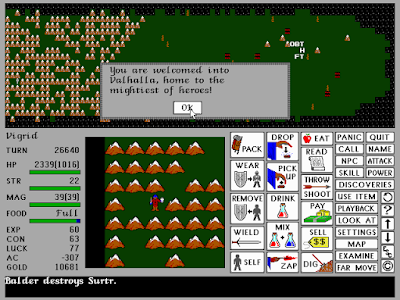 |
| I’d say that’s better than getting membership in a guild. |
Ragnarok
United States
Norsehelm Productions (developer and publisher); distributed in Europe as Valhalla by Optyk
Released 1992 for DOS
Date Started: 28 January 2020
Date Ended: 26 February 2020
Total Hours: 23
Difficulty: Moderate-Hard (3.5/5)
Final Rating: (To come later)
Ranking at Time of Posting: (To come later)
Summary:
Ragnarok is an excellent freeware game with a roguelike base. Veterans of Rogue or NetHack will soon become familiar with the partly-randomized game maps and the game’s 47 keyboard commands such as (A)ttack, (i)nventory, (q)uaff a potion, and (Q)uit and save, but they will also appreciate the original and varied things that the developers did with potions, scrolls, wands, and other inventory items, as well as the interface upgrades. The story is also richer here than in most roguelikes, requiring the player to solve a series of quests that will turn things in the gods’ favor at Ragnarok. Character development, inventory, monsters, and combat tactics are particularly strong, but as with most roguelikes, there isn’t much “role-playing.” The game allows saving every 200 turns, which takes the edge of the permadeath of other roguelikes but still requires the player to act judiciously.
*****
What a ride. I was up late with this one Wednesday night, and even though I had to play through the endgame a couple of times, I never got bored with it.
Ragnarok is one of the best games of 1992 and my blog in general. A lack of any real “role-playing,” including NPCs, will prevent it from reaching the absolute top spot, but it’s excellent for what it does.
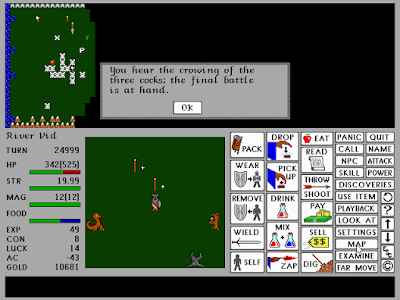 |
| The game warns me to stop wasting time. |
Late in my last session, Heimdall had warned that Ragnarok was at hand. Relying on one commenter’s statement that there was no time limit, I ignored Heimdall and kept exploring around the River Vid, which wraps around the base of the world. As I was screwing around, a comment happened to come through from Thomas Boyd that there is, in fact, a time limit. Right about then, Odin appeared before me and his voice came booming from his astral form:
Many days will the gods battle fiercely with the forces of death. Make haste to reach Asgard but take care as well. You are the only hope that we have left. Aid us and join the ranks of mortals who have been honored with greatness. Fail and the universe shall perish. First, take Gjall to Heimdall at Bifrost or we shall be overwhelmed. We await you at Vigrid.
At this point, I only had solved two of the six quests: I had found Freyr’s sword, Mimming, and Odin’s spear, Gungir. I knew where the Miner’s Well was to solve the third quest, and I had Thokk’s soul in a ring, which would allow me to solve the fourth if I could find Hela in Niflheim. I hadn’t heard a word about Mjollnir or a weapon that would allow Tyr to fight with one arm.
I headed back to Mimer’s Well and used my Wand of Wishing to generate a Scroll of Knowledge, which teaches you one skill or ability. I think it selects at random, so I took a save just before using it, prepared to save scum for the “Swimming” ability, but I got it on the first try. This allowed me to enter Mimer’s Well, where I promptly sank to the bottom, couldn’t move, and was soon slain by the serpent Aspenth. Apparently, I had to divest myself of heavy items first.
 |
| Mimer’s Well had a fun title screen even though it was only a small area. |
I reloaded, and suddenly the game had never heard of “Swimming.” It took me about 12 reloads before I finally got the skill a second time, dropped most of my heavy stuff, and entered the well again. This time, I was able to maneuver. I drank a couple of Potions of Speed and attacked the serpent in melee range, killing him in about four blows. He dropped Gjall, Heimdall’s horn, and I snagged it.
Worried about time, I figured 50% of the quests was good enough to try. I made my way back along the River Vid to the Bifrost, which occupies its own map. Heimdall was standing at the end. He gratefully took the horn and blew it to call warriors to the final battle, then disappeared. I followed him north off the bridge and into Asgard, at which point the game told me that the Bifrost collapsed and I wouldn’t be able to use it to return.
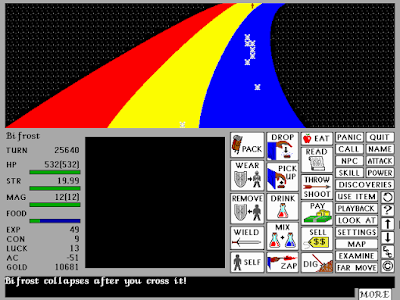 |
| Not so much a “rainbow” bridge as a Romanian bridge. |
Asgard was under attack, with enemies and allies everywhere. I didn’t last long. In addition to hel dragons and draugr, which killed me in single blows, the map was swarming with a handful of unique demons. One of them had a piercing wail like the zardons I’d made extinct. Another could sap my strength from a distance.
 |
| I didn’t last long in this crush of enemies. |
I reloaded an old save, from before I wasted so much time exploring the River Vid, and considered my options. Clearly, I needed to develop my character a bit more, with whatever time I had remaining, but also perhaps get some better equipment. Character and inventory development in Ragnarok are both consistent and rewarding because there are so many different methods. These include:
- Regular experience and leveling.
- Finding and quaffing Potions of Experience.
- Raising your strength with Potions of Strength.
- Raising your constitution with Potions of Constitution.
- Raising your luck with Holy Water.
- Finding better items of equipment.
- Improving your primary weapon or any piece of armor with Scrolls of Enchantment (preferably blessed).
- Improving your constitution by eating hel dragons.
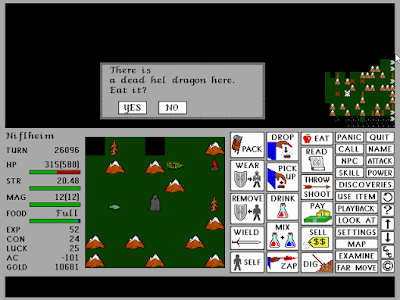 |
| Hel, yeah! |
- Improving your speed by eating blurs (this is temporary but long-lasting)
- Improving levels, for a while, and then maximum hit points by eating dead wraiths.
If you explore an area that generates a lot of monsters of different types, like the dungeons, it’s nearly impossible that something on this list isn’t going to happen every few minutes. Thus, I spent some time back in the forest and dungeon just hewing through monsters and finding items. I saved every 200 turns unless I hadn’t accomplished anything in those 200 turns, at which point I loaded the previous save and tried a new area.
Speed is worth a note. A high speed allows you to attack multiple times for every one attack from an enemy, and I found that it was absolutely necessary for some high-level enemies like hel dragons. The character has 10 by default and can boost it up to 60 or 70 with potions, dead blurs (a monster), and the Amulet of Quickening. Above 70 runs the risk of killing you. Unlike all the other attributes, I don’t think there’s any way to make the increase permanent. Potions and blurs wear off and even the amulet eventually loses its power and becomes an Eye of Sertrud (it turns out you need five of these to retrieve Mjollnir). Thus, it becomes important, particularly towards the endgame, to load up on speed-granting items. Since potions don’t stack but dead bodies do, at some point I used one of my wishes for 10 dead blurs. It worked, and that supply kept me speedy for most of the rest of the game.
At some point, I figured I’d try to re-visit Niflheim and see if I could make it to Hera. I was feeling pretty strong, and I had a Wand of Wishing with 5 charges and no particular idea of how to spend it. Niflheim turned out to be as hard as I remembered, but I learned how to use speed to keep ahead of hel dragons. I’d attack them, dart away, wait for them to close, then attack again. Eating their corpses significantly boosted my constitution.
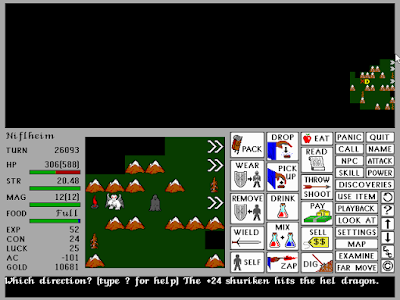 |
| Taking out a hel dragon with throwing weapons. |
Niflheim consists of 9 maps arranged in a 3 x 3 grid. Each one is ruled by a demon lord, and I recognized a lot of their names from the battle at Asgard. Apparently, if you don’t kill them in Niflheim, they show up in Asgard. Thus, I took my time trying to kill them here. It wasn’t easy; they’re all immune to wands and have a variety of special attacks. Here’s the rundown:
- Konr Rig: a powerful fighter-type demon. He can drive you insane, so you have to kill him before that happens. He’s immune to wands and missile weapons. I had to get my speed up to the highest levels and kill him with a few melee blows.
- Vanseril: Hardest of them, I think. He has a psionic attack that he uses every few rounds, and it will damage you for several hundred points anywhere on the map. I had to look up an online hint to see that the only protection was a Disperser Helm, which hadn’t shown up in the game for me. I ended up wishing for one. But even then, he can drain your strength from anywhere on the visible map. It took me almost an hour to kill him with hit and run tactics using missile weapons and speed.
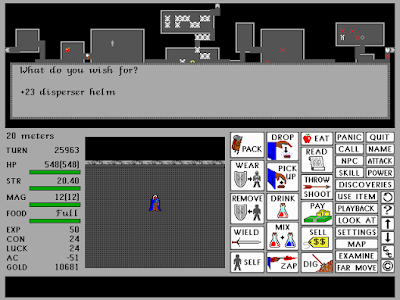 |
| When wishing for things, you can wish for a “+” equal to your current luck. |
- Plog: Easiest of them. He summons monsters and drains wands, but I learned to just drop my wands and wait until he came into melee range.
- Emanon: An annoying demon who takes your equipped weapons and armor. I killed him with throwing weapons.
- Anxarcule: Second-hardest. He can steal your equipped weapon, create copies of you that fight you, and eat your legs. And he’s also immune to wands. As with the others, I used a combination of speed and missile weapons to kill him.
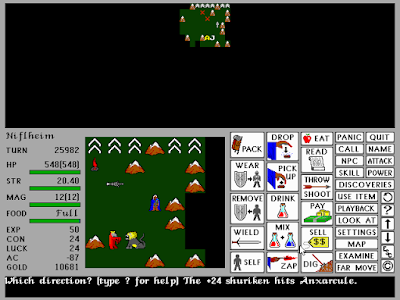 |
| Speed and missile weapons are the key to this whole area. |
- Nidhogg: Not only is he immune to wands, he removes all their charges if you try to use them anywhere on his level. (That was a reload.) He also messes with the items in your backpack, turning them into useless items. Again, it was missile weapons and speed that finally did him in.
- Gulveig: This guy was easy. Two whacks.
Hela occupies the final section, and when I first approached, she took Thokk’s soul and asked what soul I wanted released in return. I said BALDER (the game’s spelling) and she complied. I then attacked her and was surprised when she died in just a few blows. She dropped a magic scythe, apparently one of the most powerful weapons in the game. Once I enchanted it a few times, hardly any enemy lasted more than one blow.
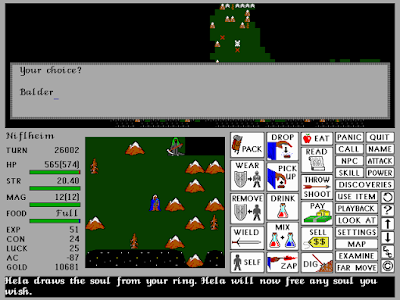 |
| Solving the fourth quest. |
Much stronger now, I returned to Asgard and started punching my way through the battle to the eastern exit. With the demons dead, I only had to worry about hel dragon and draugr. Draugrs return to life a few rounds after you kill them unless you (uck) eat their corpses.
 |
| The chaotic final battle in Asgard. You must make your way from the left side of the screen to the right. |
Asgard has several buildings. One of them, in the mid-south, had stairs up. On the second level, three rooms held stacks of almost all the items in the game, including blessed versions of every scroll and potion–15 of them! I gorged myself on Potions of Strength, Holy Water, Scrolls of Enchantment, Potions of Constitution, and the like. I rendered a dozen creatures extinct (including most of those fighting below, but draugr an hel dragons are too powerful). I used Potions of Endurance to pump up my temporary health to ungodly levels. I loaded every free inventory slot with blessed Potions of Curing. Scrolls of Knowledge filled in every skill I didn’t have
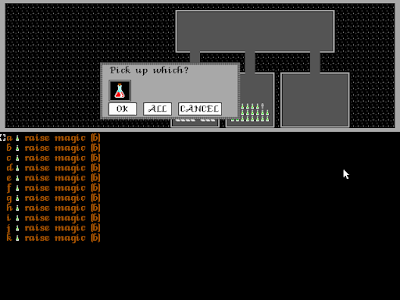 |
| A bonanza of items just before the end. |
It all turned out to be useless. A few steps later, I was off the Asgard map and onto Vigrid, site of the final battle. The game immediately started telling me that Heimdall was fighting Loki, Odin was attacking Fenrir, and so forth.
 |
| The character joins the battle in progress. |
Giving the weapons I’d recovered to Odin and Freyr involved simply walking up to them. However, there was nothing else I could do. If I tried to attack any of the evil gods or monsters–if I even caught their attention–they would kill me from afar.
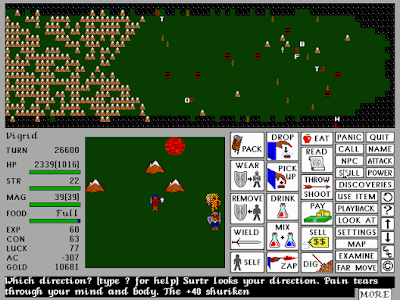 |
| Sometimes it’s best not to be noticed. |
Thus, all the bonuses I’d gained in Asgard served for nothing. I just wandered back and forth until I got a message that the gods had won the battle and I was welcomed into Valhalla. This was accompanied by a nice image.
 |
| A real paradise would have more outlets near those tables. |
So you only need to solve some of the quests. I’m not sure you’d even have time to solve them all. I guess the fewer you solve, the less likely the gods are to win at Ragnarok, but I frankly couldn’t even make a loss happen. When I reloaded from my first step into Vigrid and refused to hand over the weapons this time, the gods still won. This happened on two more reloads.
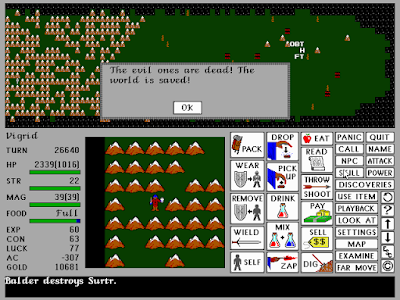 |
| I guess they really just needed Heimdall. |
In addition to the two major areas I never explore and the two quests I didn’t solve, there are many aspects of the game I didn’t experience, including:
- Making use of spells or psionics (apparently, every time you pick up a “diamond needle,” you get better at psionics).
- Dimension traveling. I got the ability when I ate a breleor, but I wasn’t sure how it worked and never had occasion to use it. Apparently it makes traveling between the major areas much faster.
 |
| “The Crossroads” lets you travel between different planes. I only even visited for this screenshot. |
- Potion making and potion-mixing. The alchemist was the last class I tried. He can mix potions into combinations otherwise not found in the game.
- Ironworking. I guess I could have had a very powerful weapon (the runesword) long before I took Hela’s scythe.
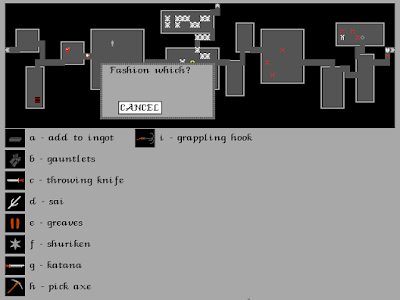 |
| Blacksmiths can make things out of other things. |
- Polymorphing, which can grant skills not available to regular classes.
- Taming animals or creating golems.
- Writing my own scrolls, a sage ability.
- Helping my allies. You can give equipment, potions, and other useful items to any human fighting alongside you at any point in the game. I didn’t explore this.
But unlike some players who prefer the so-called “completionist” approach, I enjoy leaving a game with plenty of content to be explored. It gives me an excuse to replay.
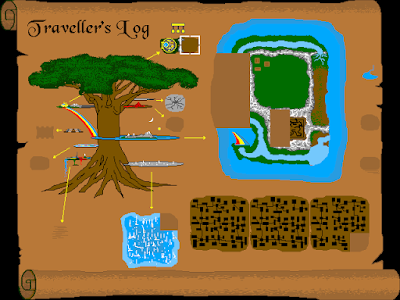 |
| The various areas of Ragnarok. Although I played for 23 hours, I still missed a lot of the maps. |
On my GIMLET, the game earns:
5 points for the game world. We’ve had other games use Norse mythology–notably Dusk of the Gods, which has the same plot. But it’s still relatively original among RPGs.
- 5 points for character creation and development. Development is satisfying, rewarding, and constant, as we saw. I don’t think the different classes matter as much as they should, though. Since they’re all capable of using the same items, the only real purpose of the classes is to work your way up to the highest level and get the class-specific skills. More benefits and restrictions would have made a more interesting game.
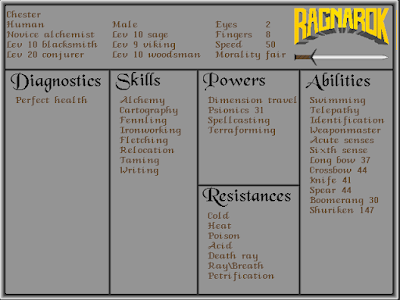 |
| My character at the game’s end. |
- 2 point for NPC Interaction. It gets this for the hint-delivering Ravens and the occasional NPC ally that you can help. It’s too bad there are no dialogue options with any NPCs.
- 5 points for encounters and foes. There are no non-combat encounters or puzzles, but the bestiary is as original and varied as its source material while not being completely derivative of it. I enjoyed learning their strengths and weaknesses and adapting my own tactics in response.
- 6 points for magic and combat. As with most roguelikes, combat seems somewhat blunt but is surprisingly tactical. I was underwhelmed by the magic system, though.
- 8 points for equipment. Easily the best part of the game. Ragnarok doesn’t feature quite as many item interactions as NetHack, but it still has a wide variety of things to find, use, and equip. You can even make your own items as a blacksmith, sage, or alchemist.
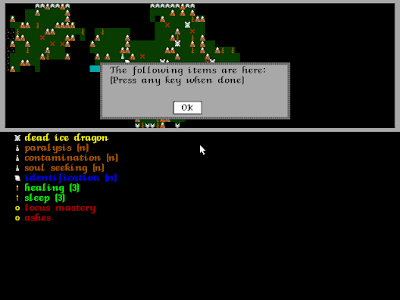 |
| Dragons always drop a wealth of treasure. |
- 4 points for the economy. You stop thinking about it, or bothering to collect gold, about halfway through the game. But during the portion when you find the occasional shop (the forest and the dungeon), it has a reasonable amount of relevance.
- 3 points for a main quest with multiple parts, some optional, but no side quests nor role-playing choices or alternate endings.
 |
| An “alternate ending.” |
- 4 points for graphics, sound, and interface. It gets almost all of it for the excellent interface. One command=one key, logically mapped, but with a mouse backup. I like the way the main interface shows both a large-scale and small-scale area. Graphics are a step up from most roguelikes; sound is sparse and only okay.
- 8 points for gameplay. It’s mostly nonlinear and quite replayable. It offers the challenge of a roguelike without the insanity of permadeath. Limiting saves to once every 200 turns is just about perfect. The game lasted exactly as long as its content supported.
That gives us a final score of 50, six points higher than I gave NetHack. Omega (1988) remains the best roguelike I’ve played so far, but Ragnarok is a close second, and frankly a better game for a player who wants a tighter storyline.
 |
| A slick ad for what was essentially a shareware game. |
As we now know,
Ragnarok was a passion project of two California-based college friends, Thomas Boyd and Robert Vawter, and I thank both of them for offering comments and recollections during my coverage. Norsehelm was their company, meaning they self-published and self-distributed the game in the United States, albeit with (as we see above) commercial production values. Their London publisher, Optyk, apparently never sent them any royalties, so the duo decided to offer it as freeware after a few years of modest income.
I couldn’t find any contemporary American reviews. European magazines mostly weren’t kind. The lowest score came from the February 1993 PC Joker, where the reviewer compared it to a flight simulator and seemed to find the number of keyboard commands bewildering despite mouse buttons, including a help menu, right on the screen. Other reviews simply suggested that the reviewer wasn’t really aware of roguelike history and was looking for fancy graphics and sound. PC Games (March 1993) had the only complimentary review, recommending it for its replayability and challenging strategy.
It’s too bad that Norsehelm never produced another game. Mr. Vawter hinted in an e-mail to me that they started one based on the Seven Wonders of the World but didn’t get very far. Both seem to have done well for themselves, however, with successful technology careers in the San Francisco Bay area.
I gave the choice of the next game to commenter Lance M., who’s helped me a lot lately with “lost” games. Lance wanted me to play GayBlade, one of the games he managed to turn up. This led to a confusing bit of research. GayBlade is listed as a 1992 game on a lot of sites, but I’ve found comments from the author that he based it on DragonBlade (1993), and moreover only released it after he got into a rights battle with the publisher of his Citadel of the Dead (1994). My attempts to contact the author have not been answered. For now, I have to assume DragonBlade came first and play it first.
Original URL: http://crpgaddict.blogspot.com/2020/02/ragnarok-won-with-summary-and-rating.html























